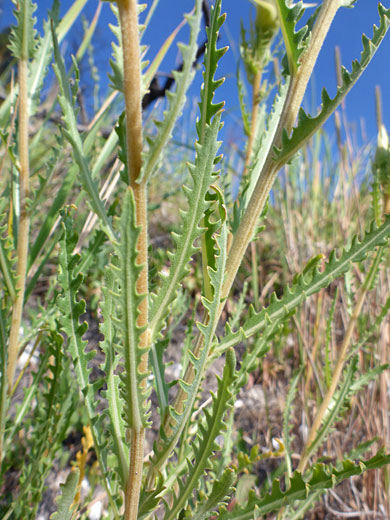Mentzelia Decapetala, Ten-Petal Blazing Star
Plants > Wildflowers > Loasaceae > Mentzelia Decapetala
Common names:
Ten-petal blazing star, evening starflower, giant eveningstar
Family:
Scientific name:
Mentzelia decapetala
Main flower color:
Range:
The Great Plains states and the northern Rocky Mountains
Height:
Up to 40 inches
Habitat:
Roadsides and open hillsides; up to 7,000 feet
Leaves:
Narrow, oblong, alternate, up to 7 inches long and 1.5 inches wide, with toothed margins
Season:
July to September
The light green leaves of mentzelia decapetala are lined with large, regular teeth, or lobes, and both surfaces have a covering of stiff, barbed hairs. Lower stem leaves are borne on short stalks; those above are sessile. Leaves have a broad, lighter-colored midvein. The stout, erect stems are light brown or whitish in color, and also hairy. The lower portion of the stems has peeling bark.
Like most members of this genus, flowers open during the evening, and close before morning. Flowers are formed of five green sepals and what appears to be ten white (less often pale yellow) petals, though five of these are actually modified stamens. At the center are between 100 and 200 actual stamens, topped by small yellow anthers. Flowers are about 4 inches in diameter, and they are produced in small numbers at the top of the stems. Flowers are subtended by a few short, leaf-like, pinnately-lobed bracts.
Like most members of this genus, flowers open during the evening, and close before morning. Flowers are formed of five green sepals and what appears to be ten white (less often pale yellow) petals, though five of these are actually modified stamens. At the center are between 100 and 200 actual stamens, topped by small yellow anthers. Flowers are about 4 inches in diameter, and they are produced in small numbers at the top of the stems. Flowers are subtended by a few short, leaf-like, pinnately-lobed bracts.
All Contents © Copyright The American Southwest | Comments and Questions | Contribute | Site Map



